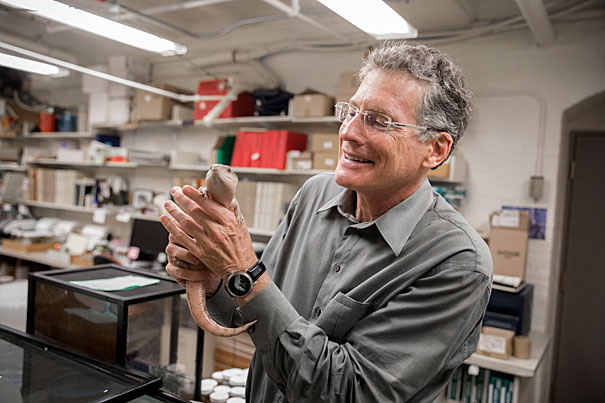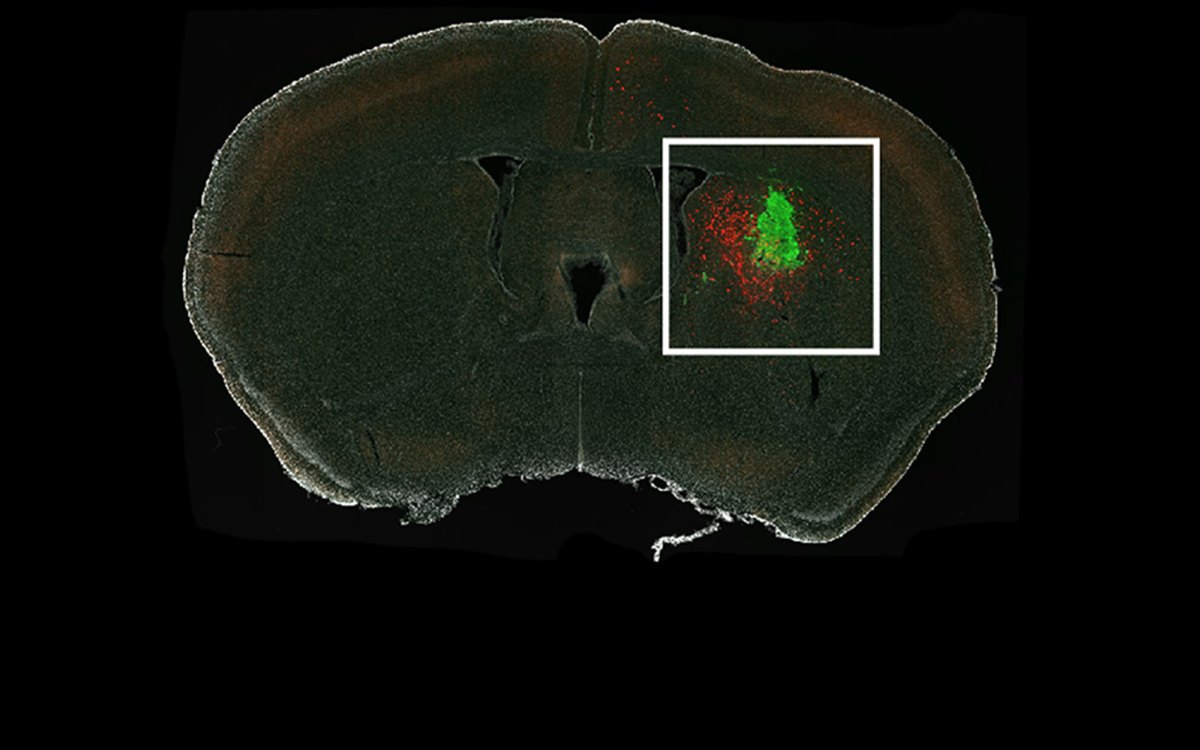A new era in the study of evolution
‘Improbable Destinies’ author Jonathan Losos on Darwin, Gould, and how field experiments have transformed his discipline
Three years ago, when Harvard biologist Jonathan Losos settled in at the Geological Lecture Hall for a talk by fellow scientist Richard Lenski, he was toying with the idea of writing a book on evolution. When the lecture was over, he was done toying.
Losos, an evolutionary biologist and the Monique and Philip Lehner Professor for the Study of Latin America, said the work described by Michigan State’s Lenski filled in a picture partly painted by experiments Losos already knew about — some of which he had conducted himself, with lizards from the genus Anolis, commonly called anoles, on islands in the Caribbean.
Lenski’s research approximated what the late Harvard paleontologist Stephen Jay Gould, who wrote extensively about evolution, might have described as “replaying the tape of life,” Losos said.
“Gould had suggested that if we could somehow replay the tape — start evolution over again from the same starting point, then we get a very different outcome,” Losos said. But Gould also knew that the project he was describing was impossible, strictly “a thought experiment,” as Losos put it.
“But Lenski showed that you can replay the tape, at least in the lab using microorganisms,” he said. “By starting 12 populations of E. coli that were initially identical and subjecting them all to the same natural selection pressures, he was actually replaying the tape, not going back in time, but letting the tape replay side by side in his 12 experimental replicates.
“Moreover, I realized that the same approach was being taken not just in the lab by Lenski and the many, many investigators he has inspired, but similar evolution experiments were also taking place in natural settings, trading the hyper-controlled environment of the lab for the natural realism of field studies. In fact, I had done some of those studies myself.”
In a Gazette Q&A, Losos discussed the book the Lenski lecture helped set in motion, “Improbable Destinies: Fate, Chance, and the Future of Evolution.”
GAZETTE: The evolution you talk about in “Improbable Destinies” is not the slow evolution described by Charles Darwin. Instead, it’s fast enough that we can observe it in real time. How is this fast evolution possible?
LOSOS: Darwin was quite remarkable in his insights. We know him for his studies on evolution by natural selection, but he actually studied all kinds of phenomena and was right almost all the time. It turned out, though, that he didn’t get it right about the pace of evolution. He thought evolution occurred extremely slowly, at a glacial pace, so much so that you couldn’t possibly expect to see it except over many, many thousands of years. We know now that’s not correct. When natural selection is strong, evolution can occur very quickly.
GAZETTE: You also talk a great deal about convergent evolution, once thought a rare development. What is convergent evolution and how does it fit into the broader picture of evolution?
LOSOS: Convergent evolution is the phenomenon when two species, or even populations of the same species, independently evolve to be similar. Most often it is the result of those species being in similar circumstances and natural selection sculpts the same adaptive solution. This is an idea that was mentioned by Darwin in “On the Origin of Species,” and we’ve known about it since.
But we didn’t think it was common. It was routinely trotted out by evolutionary biologists as a great example of the power of natural selection to come up with the same answer to problems posed by the environment. [But] when biologists discovered convergent evolution, they’d use words like “striking,” “exceptional,” “unexpected,” emphasizing that this is not the norm. We now know that convergent evolution occurs quite commonly.
One of the reasons is that we’ve been using DNA sequencing to build evolutionary trees. These trees — called phylogenies — indicate that species that we used to think were closely related because they are similar in appearance, or anatomy, or whatever, are not. Their similarity is not the result of recent shared ancestry, as we thought, but of convergent evolution.
One example from the book is a sea snake in the seas around Australia, India, and elsewhere in Asia. Scientists thought it was one species, with a remarkably broad geographic distribution. When scientists finally sequenced its DNA they found that populations in different places were not closely related to each other. Instead, each was more closely related to other snake species in their own area and so their incredibly close similarity to other sea snakes was the result of convergence.

GAZETTE: Talking about evolution that’s fast and convergent leads to your own work. Tell us about the lizards of the Caribbean, and what your studies found.
LOSOS: For my Ph.D., many years ago, I studied Anolis lizards. Many people would be familiar with them because they’re very common in Florida, elsewhere in the southeastern United States, and on the islands of the Caribbean. They have a flap of skin underneath their neck that the males stick out when they’re courting females or fighting with other males. There are 400 different species in this group spread throughout the tropics of the New World, so they’re a great evolutionary success story.
One aspect on which I’ve focused much of my career is that the lizards on each of the big islands of the Caribbean — Cuba, Puerto Rico, Hispaniola, and Jamaica — have for the most part evolved independently. And, from one or a few ancestral species, they’ve diversified into many descendant species. But evolution has taken a very similar course.
On Puerto Rico, if you walked into the rain forest and sat quietly, after a few minutes the lizards would forget you were there and you’d see that there are species living in different parts of the forest and that these species have different anatomical features. For example, species near the ground have very long legs to run and jump on the ground. A species high in the canopy is green for camouflage and has big toe pads to hang on. Another species lives on twigs and has very short legs to maneuver carefully on irregular surfaces. So these species have diversified to adapt to the different parts of the habitat that they use.
What is remarkable is that when you go to other islands, you see these same habitat specialists. So, for example, each of the islands has a twig anole — an elongated species with short legs, very camouflaged — and the species on the different islands look similar enough that you’d say they’re probably the same species. But they’re not. They have independently evolved these characteristics. And each island has each of the types of habitat specialist.
It’s a great example of convergence, but on steroids, if you will. Not just convergence of one type, but of an entire ensemble of species adapted to different parts of their similar environments.
GAZETTE: And you used this insight later in your career to actually engineer evolution and to watch it happen?
LOSOS: These lizards, I should point out, have evolved over millions of years. But they suggest that using different parts of the habitat — broad tree trunks, leaves up in the canopy, narrow surfaces — has selected for them to evolve different anatomical features. And that suggests that an ideal experiment would be to expose a lizard species to new conditions, a new habitat, and we would have clear predictions about how they would adapt to that habitat.
So that’s exactly what we did. Working in the Bahamas, we were able to take a species that lives on broad tree trunks near the ground and move it to tiny little islands where there were no big trees, there were only scraggly little bushes. So they had to use narrow little surfaces to sit on. Our prediction was very clear from our studies on the big island — that they should adapt by evolving shorter legs. And that’s exactly what they did and over a relatively short period of time.
GAZETTE: What comes through in the book is a real enthusiasm and excitement for the work. The ability to actually study evolution and conduct experiments on it in real time seems to have energized the field. What’s it like being able to study these fundamental questions?
LOSOS: It’s spectacular. Evolutionary biology, for the first century of its existence, was thought of as a non-experimental science, one with more similarity to history than laboratory sciences. The idea was: You can’t go back in time and see what happened, so you just have to try to figure it out.
But the ability to do experiments changes all that. We can now not only formulate hypotheses, but also test them using the gold standard of science: manipulative experiments. People have been doing laboratory experiments for decades, but to do experiments out in the field, under natural conditions, is something that is only really taking off right now. It allows us to formulate ideas about how evolution has worked based on our observations of diversity today and in the past, and then to investigate these hypotheses with mechanistic studies, experimentally testing how evolution occurs in response to presumed selective agents.
GAZETTE: Your book talks a lot about convergent evolution and the predictability of evolution under certain circumstances, but you also conduct a thought experiment about whether humans — or something humanlike — would have evolved if mammals weren’t around. And in this case, despite ample evidence of convergence, it seems you’re saying that randomness hasn’t gone away, and if you start at very different starting points, you’ll end up at very different end points, even under similar natural selection pressures.
LOSOS: One of the great questions transcending evolutionary biology is: How destined was the world to be as it is today? If events had transpired differently in the past, would the world be very different?
Historians ask this all the time. What if Churchill had been run over by a car in New York City in 1931, as almost happened? What if Kennedy hadn’t been assassinated? How different would the world be today? And evolutionary biologists ask the very same question. If you look at the plants and animals in the world around us, are they the inevitable result of evolutionary processes of natural selection, or just the result of the particular events in Earth’s history that sent evolution down one road and not another?
This debate was catalyzed by Gould, who wrote a book in 1989 titled “Wonderful Life: The Burgess Shale and the Nature of History.” In it, Gould argued that evolution was not destined to produce particular outcomes. He said if we could somehow go back in time and start again from the same starting point, the outcome would differ every time. Any sort of minor change that might seem inconsequential at the time could lead one individual to survive and not another, cause one mutation to become common and not another, and evolution would go down a very different road. Replay the tape a million times, he said, and something like humans would never evolve again.
This was a very influential viewpoint but it was based on no data. There was nobody doing these sorts of experiments. However, the idea really excited a lot of people, so there’s been a lot of attention to the question over the last 30 years. And the reason I wrote the book is that I realized we do have a lot of empirical data now addressing the question of how repeatable, or how predictable, evolution is.
One school of research that has arisen has focused on the phenomenon of convergent evolution, of the same evolutionary outcome occurring multiple times. A number of people argue that convergent evolution demonstrates that Gould was wrong. The environment poses similar questions to species living in many different places and there are optimal solutions that natural selection finds. As a result, you can predict, almost, what sort of outcome you’d get in a particular evolutionary circumstance, and that solution evolves time and time again. Contrary to what Gould argued, these other scientists argued that particular outcomes are inevitable. And that is how convergent evolution has been used by some scientists to contest the idea of the haphazardness, or the flukiness, of evolution.
GAZETTE: And your own conclusion is somewhere in the middle, right?
LOSOS: Yes, and the reason is that these scientists are absolutely correct that convergent evolution is much more common than we used to appreciate. It does show the power of natural selection and there are some outcomes that do occur repeatedly. So there is truth to that.
But the argument basically comes down to a long list of examples of convergent evolution and you could make a similar long list of examples of failure to converge, of species exquisitely adapted to their environment but with no parallel anywhere else in the world.
My favorite example is the duck-billed platypus. Here’s a species that comes in for all kinds of ridicule as being a comical, ridiculous animal, but that’s really not fair. They’re actually extremely well adapted to the environment in which they occur, the streams in Australia. They have a suite of features — lush fur, webbed feet, powerful tail — that make them very well-adapted.
The most important feature they have is their bill, which looks like the bill of a duck, but which is very different from that of a duck. It is covered with sensors that detect both tactile information — the slight ripple of water as a fish swims by — and the electrical discharges that any animal gives off as it moves. Using those two senses, they can find their food underwater even though their eyes are closed and their ears and noses are closed. So, they’re actually remarkably well adapted to the streams in which they live. But those streams are nothing special. We have similar streams all around the world, and yet there’s no duck-billed platypus in any of them. It evolved once in Australia, without a parallel.
There are many examples of this — elephants, kiwis, giraffes. These are species very well adapted to where they live, environments that occur all around the world, and yet there’s no convergent evolution.
You could make a very long list of examples of nonconvergence. The debate so far has been people arguing that convergence is more common or nonconvergence is more common. And that debate has gotten quite stale, because, in fact, they’re both quite common. It doesn’t really matter whose list is longer. The real question we now have is: What circumstances lead some species to evolve convergently, evolve convergent solutions, and in which cases do they follow different evolutionary courses, finding different adaptations to the same selection pressures? And that’s the sort of work that’s going on in many places around the world, including some labs here at Harvard.





